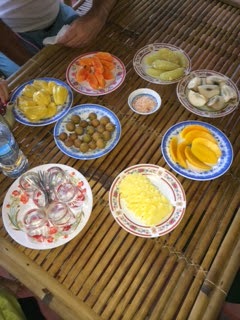2.17.2014
Greetings from Vietnam!
I have now been working with the brilliant dermatology faculty and residents of Ho Chi Minh City College of Pharmacy and Medicine for one week and I must say this has been one of the most memorable and impressionable learning experiences I have encountered throughout residency.
A little background for you�.. For years, the country of Vietnam has lacked the appropriate means for effective, early intervention of disfiguring vascular anomalies. The standard of care has historically included the use of radioactive phosphorus for infantile hemangiomas and even in some cases vascular malformations. This treatment is not only painful for the children but leaves behind disfiguring, stigmatizing, and painful scars, many of which are located in the facial region. Five years ago, Dr. Thanh Nga Tran and Thuy Phoung (both natives of Vietnman) decided they would put a stop to this treatment once and for all. Both having trained in the Harvard Dermatology and Dermatolopathology programs respectively, they determined to join forces with Dr. Rox Anderson (expert in the laser and medical treatment of vascular anomalies) and Dr. Martin Mihm (expert in vascular anomalies and dermatopathology).
Dr. Tran spent one month at the Ho Chi Minh College of Pharmacy and Medicine as a senior dermatology resident and during this time made contact with two of the most honest, hard-working, and caring dermatologists any of us has met, Drs. Hoang Minh and Bo Famy. Together, this remarkable team of physicians established the first vascular anomalies clinic of Vietnam five years ago this month.
The clinic began with 1 laser, the pulsed dye laser, an operating room with anesthesiologist, a team of eager residents, and of course a line of patients. Through much fund-raising and generous donations from various laser companies, the OR is now replete with the top four lasers needed for the treatment of various vascular anomalies. This accomplishment in only five years time is truly remarkable.
Now for the present�..Upon arriving in Vietnam at 1:30 AM, the hospitality of this program was evident immediately. Second year resident- Anh Dao was there with her little brother holding a sign with my name as soon as I exited the airport in Ho Chi Minh City. I must say this was so comforting having never been to this country and not speaking the language.
Our first day in clinic was truly an eye-opening experience. It began with the evaluation of several children with disfiguring scars from the treatment with radioactive phosphorus. In the year previously, Dr. Anderson was able to bring a new device that he invented which harvests a �blister graft� from the thigh, which can then be grafted to the site of a scar (after superficial epidermal ablation). He trained Drs. Famy and Minh on the utility of this device and they were able to treat several of the children in the last year. The results are truly remarkable! Nearly normal pigmentation and texture resulted. This is life changing for these children whose scars are located in the facial region. Additionally, this is ground breaking in the treatment of radiation injury. Thankfully, we were able to treat several additional children during our time this year.
Additionally, we evaluated and treated numerous children with hemangiomas, capillary malformations, lymphatic malformations, and venous malformations.
It was amazing to observe how brave these children are here. They literally walk into a room of 15-20 physicians and sit in the middle quietly while we discuss the treatment plan.
A great deal of our time was also spent teaching the residents and attendings how to develop treatment plans, including the use of medical management, such as topical timolol and oral propranolol, in combination with laser treatment. At the end of the week several members of our group spoke at the annual CME conference held at the University. Much to our surprise, this year�s attendance hit a record high of over 500 doctors from across Vietnam!



















